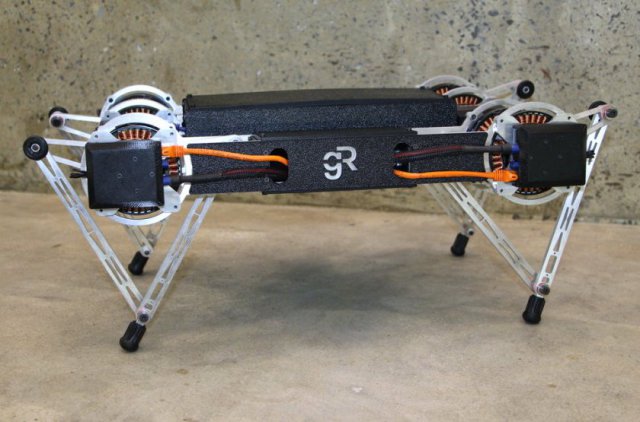A new robotics startup has launched a sprightly little quadruped robot that is able to scale fences, manipulate door handles, turn back flips, climb stairs and jump up and down while keeping its balance, almost like a robot version of Jiminy Cricket.
The Minitaur is a four-legged robot measuring 15.6in by 10.8in that weighs just over 5kg and can carry a payload of over 3kg.
The robot features patent-pending gear-less direct drive motors that behave like springs and a specialized leg design with sensors that work together to provide precise force feedback, so that the robot can balance and reorient itself from a fall while running and jumping over difficult terrain.
Powered by a 72MHz Arduino-compatible robot micro-controller, the robot features high speed and high resolution encoders that enable the robot to sense the ground and process the feedback from the sensors and adapt to situations in real time to keep itself from over-balancing.
A robot that understands how to open a door by itself
Minitaur currently retails for $10,000 (£7,670) and has a maximum running speed of 2m/s and a turning speed of 1 rad/s. Users can program the legs to work with a variety of gaits including trotting, walking, bounding and walking, which have been inspired by different animals and how their gaits change when they approach a range of obstacles.
The robot is the brainchild of Ghost Robotics, a startup spun off from Professor Daniel Koditschek’s robotics laboratory at the University of Pennsylvania in the US by two of Koditschek’s PhD students Gavin Kenneally and Avik De.
At the moment, the majority of robots are wheeled or tracked, because it is very difficult and expensive to get legs to animate properly – a key example is the humanoid robot Atlas created by US robotics firm Boston Dynamics, which is being sold by Google because it failed to ever deliver a product that could be commercialized.
By using a legged robot with motors in the legs that are able to simulate springs and software that can make intelligent decisions instantaneously about gaits, force and speeds, the robot is able to right itself, prevent falls and balance itself while completing a complex task, such as trying to scale a chain link fence.
The most impressive feature of the Minitaur robot is that it is able to autonomously decide to jump up into a handstand on its front two legs, perceive where a handle is on a door, take another jump up to the door and prepare to retract one of its legs at just the right moment in order to manipulate the handle to open.

Making legged robots successful means they must be reliable
Watch any robotics competition and you’ll see a plethora of robots falling over and failing to complete the tasks requested of them without a great deal of human input. In order for robots to really take over our jobs or be able to help us with complex tasks, we will need to reach a point in robotics whereby the robot is affordable, easy enough to mass produce and reliable enough to guarantee a consistent performance.
Kenneally and De foresee their robot being used for a huge variety of purposes – Minitaur could carry payloads to monitor public safety; it could be used to survey terrain for mining, exploration or field survey; it could be used by the military during delicate operations; or to provide support in medical emergencies and to help monitor crops for farmers.
“What we’re finding out, interestingly enough, is that there’s an opportunity for these low cost legged robots out in the field as a 24/7 mobile sensor platform. We’re thinking about anything where you could use mobile sensors. Search and rescue. Military applications. Space exploration. There are scenarios where lightweight, low cost, very few moving parts, could be fairly compelling,” Ghost Robotics’ CEO Jiren Parikh told IEEE Spectrum.
“These are standard parts, off the shelf. If it can get up into a commercial environment with a prototype fairly quickly, manufacturing costs on this in volume could get to $1,500 a device. And probably less than that. That’s us just doing a rough estimate right now. What Ghost has done that’s unique is the fact that Minitaur is direct-drive, and these machines can be ultralight and can be deployed at a very cost-effective, scalable model.”
Source: IB Times
